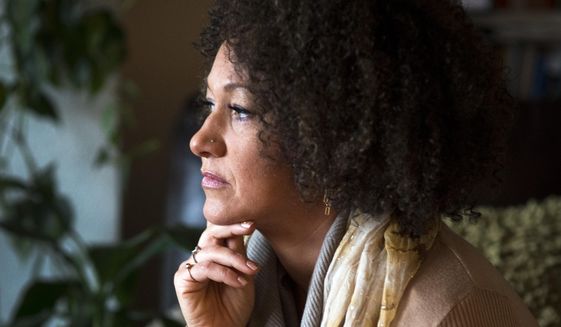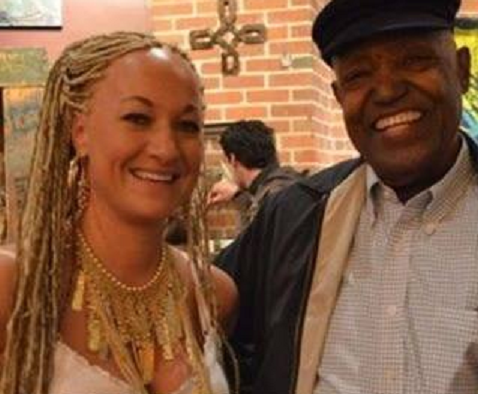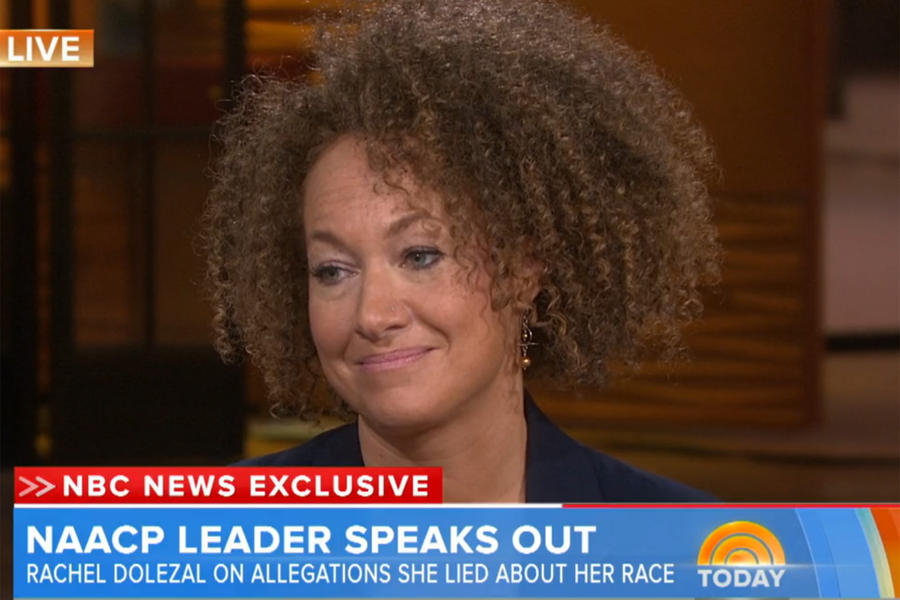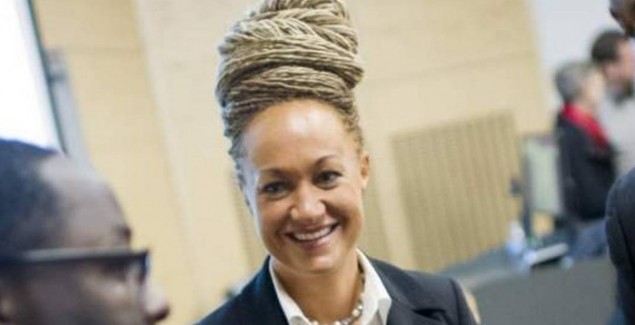
If you spend any time thinking about race or identity politics, you have by now heard of Rachel Dolezal, the (former) president of the Spokane chapter of the NAACP who for several years passed as a (multiracial, light-skinned) Black woman until her parents revealed early last week that they are both White.
Because we haven’t had enough thinkpieces on this subject, here’s another. (Yes, that’s sarcasm.)
This story took social media by storm, with each day revealing new details of Dolezal’s life: born in Montana and growing up with blonde hair, pale skin, and blue-green eyes, Dolezal reportedly increasingly identified with Black culture when her family adopted her two (Black) brothers. As a college student, Dolezal applied to Howard University as a fine arts major with a portfolio that focused on Black subjects, and was admitted on a scholarship. During her time at Howard, Dolezal identified as White, and when she graduated in 2002, she sued the school claiming racial discrimination when she was not offered a teaching position and when some of her work was removed from an exhibit to make room for other artists; the courts failed to uphold her claims.
It was at some point after Dolezal graduated and before she moved to Spokane that she began altering her appearance — darkening her skin and wearing her hair in braids — to (intentionally or unintentionally) lead the casual observer to assume she was multiracially Black. Perhaps initially, Dolezal simply chose not to correct those who made assumptions about her racial identity based on her appearance, but by the last few years, Dolezal was taking increasingly elaborate steps to maintain the subterfuge: she applied to a City commission position (which she received) while self-identifying as White, Black and Native, she wrote numerous social media posts subtly crafted to self-identify with Blackness, she presented her younger adopted brother as her own son, she identified an unknown older dark-skinned Black man as her father and fabricated a story about him forced to flee the Deep South, and she gave an hour-long interview with a graduate student (available in five parts on YouTube) where she recounts an apparently entirely made-up story of her life as a multiracial Black child discovering her Blackness at an early age.
Today, she told the Today show, “I identify as Black”.
As we approach this story, we must also question why and how this story came to be. Dolezal’s parents — estranged from Dolezal for many years — claim they are motivated only by the ethical implications of Dolezal’s racial performance. However, reports published this week say that last week’s revelation regarding Dolezal’s heritage may be an effort by Dolezal’s parents to discredit Dolezal, who has sided with the alleged victim in a sexual assault case involving Dolezal’s older biological brother. If so, anyone who chooses to write about Rachel Dolezal must acknowledge that this entire story may be part of a smear campaign designed to protect a sexual abuser from being held accountable for an alleged crime. Such smear tactics are disturbingly common countermeasures used to absolve those accused of rape and sexual assault by undermining the character of their (typically female) victims and their supporters.
Despite the circumstances of these revelations, however, we also cannot simply ignore the implications of Dolezal’s attempts at racial transformation. Dolezal’s attempts at passing enthralled the nation with equal parts fascination and disgust, in no small part because it raised for many of us weighty and confusing questions on the very construction of race: What constitutes membership in Blackness? Can a person not born into Blackness (or Whiteness or Brownness) simply choose to switch their race? If so, what would be the mechanism of this transformation? Is race-switching a one-way street?

Discussion over this story also takes on a few disconcerting overtones. I posit that this story has fascinated the mainstream at least in part because many secretly wonder why a White person would choose to become Black: a question that relies upon the assumption that there is something innately irrational about wanting to be (or to become, if that were possible) Black. We do not express the same degree of angst with stories of dark-skinned Black or Brown individuals — Michael Jackson (who also had vitiligo which necessitated some skin lightening to remove patchiness associated with melanin loss, but who also underwent other forms of plastic surgery) or Sammy Sosa, for example — who take deliberate steps to affect (to varying degrees of success) passing as light-skinned or White. Our fascination with Rachel Dolezal’s tale (and tales like it) is rooted in its cognitive dissonance with the White supremacist logic that would assert that only Whiteness is the desirable racial state.
This story has also facilitated what I can only describe as an organic collaboration between social conservatives and trans-exclusionary radical feminists (TERFs) (strange bedfellows, indeed!) to troll the trans community by likening Rachel Dolezal to Caitlyn Jenner. That comparison is so deeply offensive — and so obviously misunderstands both the trans experience, and so clearly ignores the essential differences in how we construct race versus how we construct gender — that I can barely dignify that line of thinking with a response; nor is it necessarily my place as a cis-woman to speak for the trans community. I would prefer to leave it to the trans community to initiate what is clearly a necessary mainstream discussion on gender as a dynamic spectrum of identity (or, as my friend Lauren wrote for a performance for the anti-oppression drama troupe we were both members of in college: “my line has more than two points”). Sufficed to say, I believe any comparison between Dolezal and Jenner can only stand if one accepts that trans individuals like Jenner are literally lying about — rather than revealing — their authentic selves; or, that biological sex is the singular and immutable basis for determining binary gender identity, and that all transition is politicized pretense. I reject such trans-exclusionary thinking on its face (or, as Lauren said on this subject when we met up this past weekend, “those people have no fucking idea what the fuck they’re talking about”).
As a myriad of Rachel Dolezal thinkpieces have established over the last week, race is a social construct that is simultaneously rigid in the rules by which race and racism operates, and arbitrary in its drawing of the boundaries of racial lines.
Many have pointed out (and rightfully so) that American ideas of racial categories have shifted in the last two centuries, with people of certain ethnic groups — Irish, Jewish, South Asian — becoming absorbed by (or expelled from) Whiteness; thus, the borders of the racial categories that govern racialization can clearly shift, which underscores how race really is a socially crafted artifice. By contemporary standards, racial membership is established simultaneously by both biological and political criteria: a person’s identity is defined both by physical and cultural cues, but perhaps even more meaningfully by one’s biological and political connection to historic systems of racism and its modern sociopolitical residue. The criteria that organizes some people into certain racial categories to the exclusion of others may again shift in the coming decades; history would certainly suggest that this will continue to be the case.
Nonetheless, Rachel Dolezal was not operating by some future definition of race; she operates by today’s definitions of race, and her attempts to pass as Black ring false because her efforts were limited entirely to adopting physical and cultural cues of Blackness. Like Vijay Chokalingam and numerous others who have used Blackface as a costume of Blackness, the charade depends upon invoking stereotypes of Black physicality and culture, while downplaying the importance of the Black political identity. Rachel Dolezal can put a weave in her hair to affect a natural style (oh, the irony) and create an illusion of Blackness, but she cannot create a lived experience with the lasting impact of chattel slavery, apartheid, or redlining. She can apply generous amounts of skin bronzer, but she cannot invent the (very real) psychological and political impacts of being Black (or Brown) in a system that continues to deny Black (or Brown) humanity.
Some have used the word “transracialization” to describe Rachel Dolezal’s efforts to pass as Black; I have used this specific word in the past to also describe the process of superficial race-switching (as it appears in comic books). My use of this word was never designed to invoke the politics of the trans community — and again, I am sort of horrified by those who would draw that comparison. I use this word in isolation to describe the kind of race-switching charade perpetrated by Rachel Dolezal. Meaningful transracialization — literally becoming another race — is impossible (as we will discuss below). This word should not be confused with transracial identity, which describes the race politics of adoptees adopted by foster parents of another race. Transracial identity is not only “a thing” (and an important thing you should learn more about), but transracial identity is “a thing” precisely because transracialization itself is not “a thing”.
Race is not just physical appearance. Race is not just cultural identification or upbringing. Race is an inherited legacy of political power, pride, privilege and pain that we carry with us from birth. It is a legacy that Rachel Dolezal cannot manufacture at her own convenience, no matter how she weaves her hair.
The essential logic of race and racism, which has remained unchanged for centuries, precludes transracialization; this logic states: 1) people can be categorized by race, and 2) racial identity is individually immutable. The very power of race and racism — as a system that exists for the singular purpose of elevating some groups of people over others — rests on the assertion of both these points. Race and racism violently protects the power of some by explicitly denying any access to Whiteness for others.
Some would argue from this, therefore, that the solution to racism is to pursue a post-racial utopia, where race is so fluid that one’s racial identity is no longer fixed. Indeed, in her interview this morning with the “Today” show, Dolezal embraced a complete de-emphasis of race to justify her racial identity as a Black woman, citing her son whom she quotes as saying, “Mom, racially you’re human and culturally you’re Black”.
But, “human” is not a race; or certainly not a race that has any meaning to everyone who has been systemically oppressed because a racist system said their race was “Black” or “Brown”, and therefore “not human”.
A post-racial utopic world might allow for transracialization, but this post-racial fantasy requires such a radical shift from our current ideas of what constitutes race and racism as to be largely inapplicable to the current world. Many (myself included) assert that a post-racial world is impossible because race is so culturally ingrained as rigid and fixed that we cannot simply wake up one day and decide to reject these definitions: there is no colour-blindness possible in a world that has only ever known skin colour. Even if we could all wake up one day and not see race, that would not erase the sociopolitical residue of race and racism that also delineate racial categories. Race is a quagmire that cannot be cast away just by wishing it so. Racial equality will come not from eliminating our capacity to see race, but from eliminating the structural iniquities that permit race to so effecitvely disempower some people compared to others.
(Meanwhile, it is worth noting that in a world where race is a choice, those who find themselves the victim of racism would logically be experiencing that racism by choice: this leaves you blaming people of colour for the racism that they face — hardly the perspective that someone dedicated to the civil rights uplift of the Black community should adopt.)
Thus, we cannot approach Rachel Dolezal’s efforts to transracialize as if it happened in some post-racial utopia where racial boundaries are fluid and somebody can claim that their race is “human”, because Rachel Dolezal didn’t perpetrate her racial fraud in this fantasy world. She did it here — in this world — where racism has power precisely because race is fixed for people of colour, and where racism underprivileges some of us because it is fixed for us. If we accept transracialization as possible in this world, it can only be possible as a privilege denied to people of colour while bestowed exclusively upon Whites.
Rachel Dolezal’s attempts at transracialization were an exercise in her own White privilege, motivated by her hope to erase that privilege when it became inconvenient to hold. All the information we have on why Rachel Dolezal adopted a multiracial Black female persona when she moved to Spokane suggest that this all started because she was so frustrated by attempting to live as a White ally in predominantly Black spaces that one day she just decided to give up her Whiteness. To MSNBC, Dolezal said, “I felt very isolated with my identity virtually my entire life, that nobody really got it and that I really didn’t have the personal agency to express it.” Elsewhere in the interview, Dolezal said she felt restricted being “limited to whatever biological identity was thrust upon me.”
Rachel Dolezal thought being White stopped being easy. And so, she took Blackness, and she took it à la carte.
Rachel Dolezal appropriated aspects of Blackness she believed she could derive personal benefit from — a perceived political legitimacy in majority-Black spaces, a relative authority on civil rights issues that allowed her to easily move to the leadership of the NAACP, the natural hair movement, a certain trope-ish “sistah cool” — but she chose not to take all of Blackness. She did not take the racial pain. She did not take the inescapable dehumanization. She did not even give up, for example, her light-skin privilege (even were that possible). She did not give up the privilege of her name being known.
In presenting herself as Black, Dolezal committed very tangible harm to the Black community. She re-centered herself as a White woman, in spaces specifically designed to center Blackness. She took scholarships, job positions, and speaking engagements intended for Black activists, artists and thinkers. She spoke for Black people — and Black women, specifically — and in so doing pushed aside countless Black women who rarely have the opportunity to speak for themselves. She took efforts that were supposed to be about Blackness, and she made them all about herself.
Some have brought up the good work that Dolezal has done in advancing civil rights. Indeed, Dolezal has done good work as a civil rights activist that should not be ignored. But she did this work to uplift the Black community while she simultaneously dehumanized Black people by treating their race as if it were a costume she could put on and take off at will — an act that inescapably invokes the history of Blackface and Brownface that has served as a centuries-old tool of White supremacy. Dolezal could easily have accomplished her civil rights work while presenting herself as a White woman: not only is the NAACP not exclusive only to people of colour, but history documents ample evidence of thoughtful White allies who successfully leverage their White privilege for the benefit of underprivileged people of colour in a manner that does not racially disrespect or dehumanize them.
The most tragic aspect of the Rachel Dolezal fiasco is how even by paying attention to this story, we replicate her co-opting of the discourse away from its possible focus on the Black community. Already, we have seen how the Dolezal story has completely pre-empted meaningful national discourse on the sexual, physical and racial victimization of a female Black child at the hands of police, or on how the McKinney pool party story played out as a contemporary manifestation on historic segregation of public versus private residential and recreational spaces.
Being a respectful White ally in a predominantly non-White space is really fucking hard. But, the role of the White ally who stands in solidarity with people of colour is to sit with the discomfort of that privilege, and to not shirk away from difficult conversations about that privilege. It is not to treat skin bronzer and a weave like a White guilt escape hatch.
And, the rest of us would do better than to treat the Rachel Dolezal story as our own escape hatch for dealing with the meatier topics of #BlackLivesMatter and #SayHerName, too.


